Cuba: Specific Recommendations
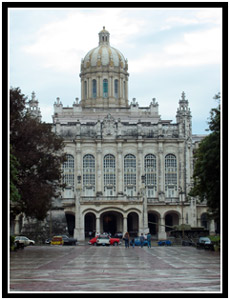 Part the Sixth: Part the First: Specific Recommendations
Part the Sixth: Part the First: Specific Recommendations
Okay, if you’ve been reading along until now, you have a good idea how Cuba is going to function. The big question is: What should you plan to do once you get there? Let me help you decide.
Havana
More than likely, you’ll end up flying into Havana to start off your trip. How much time you spend in Cuba’s largest city depends mostly on how much you like big cities. Rest assured that no matter how long you plan to be there, there will be too many things for you to see.
Museo de la Revoluccion and Bellas Artes
A few years ago it finally dawned on me that I don’t actually like museums. Go ahead, call me uncultured, but after countless visits where I pour over the details of the first half of a museum and feel guilty about skimming hurriedly past the second, I just gave it all up. Cuba’s Museum of the Revolution, though, almost changed my mind.
The Museum of the Revolution is situated in a beautiful palace in Old Havana and its goal is to chronicle the great achievements of the Cuban Revolution over the last 45 years. What interested me most was the spin of the propaganda contained within. Our U.S. version of many events is very different from the way Cuba views them. History is written by the winners, they say, and I find it refreshing to see both sides before it’s written at all.
For the military buffs, there’s a covered display behind the museum that has some assorted military hardware and the boat that brought Fidel and his initial revolutionaries over from Mexico. There’s a tank out front, too, if you’re into that sort of thing.
If you’re one of those that enjoys a full day (or two) of museum crawling, the two buildings containing the “Museum of Beautiful Arts” is right next door.
Waterfront, Castillo de Real Fuerza, Catedral, El Faro
Walking down the Malecón in Cuba is a scenic experience all its own. Getting to the end of it (east) is the start of the tourist trap areas. Not that that’s a bad thing, mind you. There’s plenty worth seeing.
First, across the bay is a picturesque lighthouse situated on an old Moorish fort that used to protect Havana’s harbor. Stop by on any sunny day and you’ll likely see dozens of Cubans swimming, fishing, snorkeling, and spearing fish in the waves off the rocks. Stop by on a stormy day and you can watch in amazement as the waves crash over the short wall that keeps the ocean from flooding Havana’s streets.
Within site of the lighthouse, you should be able to see a tall statue in a nearby, Old Havana park. While the statue is photo-worthy in its own right, I suggest getting a little closer and meeting the people that live inside. Yeah, inside. There’s a husband and wife that have been living in the tiny bowels of this statue for 23 years. My impression is that he’s the self-appointed caretaker. Careful – he’ll invite you inside and talk your ears off about how horrible Cuban’s government is while his wife laughs and calls him crazy.
Continue east along the bay and you’ll come across the touristiest (holy crap, that word’s actually in Word’s dictionary!) spot in Old Havana. You know you’ve arrived when you see rows of buses next to a few expensive waterfront cafes. Across the street is another Moorish castle (with blue trim) which I’ve never been in, but have enjoyed by sitting moat-side on the grass.
Another block inland will bring you to the Cathedral. In front of the church is a cobblestone plaza with outdoor cafés and streets leading tourists to their fanciest hotels and costliest stores. Also nearby is one of only two artisans markets I saw in all of Cuba – stop by if you’re dying to buy a painting or a typical knickknack or doodad with the word “Cuba” stamped on it.

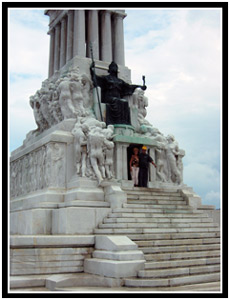
Capitolio
The old capital building is now a museum only about 6 or 7 blocks up the Prado from the waterfront. Modeled a lot like our own capital building here in the U.S., I think it’s at least worth a look. Go inside and buy yourself an unguided tour or sit on the steps and watch the world go by. Also, one of my favorite souvenirs from Cuba happens to be a grainy black-and-white photograph of our group taken and developed by a photographer hanging out by the capital steps.
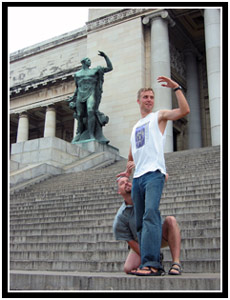
Béisbol
Watching a baseball game in Havana is easy to find information about, cheap, and loads of fun! Ask just any male Cuban on the street when the next game is and grab yourself a cab to the stadium (it’s out of the way, though, so you might ask the driver to meet you back there when the game’s over.)
As a foreigner, you’ll be expected to pay a dollar to get in (instead of the 3-peso price that the locals enjoy.) We splurged for the good seats and had to pay a whopping $3 each. Not bad at all for an evening of excitement beneath the big lights.
While the game is played just like it is in the States, complete with angry players shouting at the umpires and dugout clearing scuffles between teams, the food leaves a bit to be desired. You might want to bring along a snack. Make sure you stay for the whole game, too. We were lucky enough to witness a great comeback by the visiting team; were seen cheering twice on live, national TV; and bought a baseball signed by the entire home team, the Industriales!

Tropicana
In my two trips to Cuba, I only stepped outside the bounds of a budget traveler once… and it was well worth the expense. On my last night in Havana I still had a couple hundred dollars cash left over… a fact of which I’m quite proud, considering I had to enter the country with all the money I was going to spend in a month.
At any rate, a friend and I decided that we wanted to check out the world famous Tropicana cabaret show. We asked around and heard all sorts of conflicting stories on the price – everything from $35 to $85 per seat. I’ve found the best thing to do in these situations is to just go and see for yourself. So we negotiated an expensive taxi ride ($6 from old Havana) and made our way to the show.
Here’s the scoop. As of January 2004, the seating is $65, $75, or $85 per seat, depending on how close to the stage you want to sit. Included is a complimentary cigar (for the men) or a long-stemmed rose (for the women), a snack plate, a can of cola, a glass of champagne, and a quarter bottle of 7-year rum. Oh, and a truly awesome show.
I don’t know quite how we managed it, but we seemed to get some sort of preferential treatment when we went to the show (by flashing an Alaska Driver’s License? It’s the only thing we could come up with). We decided to pay for the $75 seats, but were seated at very front table, right up against the stage. We also never received any tickets – instead we had our own chaperon to escort us past a mob of people. The fee for taking pictures with out cameras was also inexplicably waived.
(This was all quite amazing to us considering how much we stood out in the place! We didn’t realize it was such a black tie affair – we entered the restaurant and saw elegant couples dressed to the nines as tuxedoed staff served drinks, played a grand piano, and wandered table-to-table serenading the upscale clientele with a violin. We sheepishly sidled up to the bar in our denim jeans and zip-off pants, ordered strong $4 drinks, and eventually gave up trying to fit in.)
The typical outdoor show was rained out that night and we were forced to wait an extra couple hours while they moved everything into a small, indoor substitute. After a very full day (our last in Cuba), we were practically falling asleep in our chair when the show finally started at around midnight. That changed when the performers started singing and dancing.
The Tropicana is a small show, but it’s right up there in caliber to what’s going on in Las Vegas. Amazing singers, a full orchestra, dancers that make the very talented Cuban dancers you see elsewhere look like, well, me. For the next two hours, we stared in amazement as colorful, scantily-clad men and women cavorted so close to us that we could hear their exhalations, see the sweat on the bodies, and feel our table shake with their footsteps.
The highlight of the show, totally worth the $75 price tag all by itself, was a pair of gymnastic performers. For about 5 minutes, a guy with the body (and costume!) of a Greek god, flipped, twirled, threw and caught a woman who posed in varies, complicated ways above his head. And he did this while standing on a small board… which was itself balanced on a rolling cylinder. I don’t believe I’ve ever been to any event that caused an entire audience to gasp in unison so often.
If you can afford it, the Tropicana is well worth the money, and a perfect end to a perfect trip, too.


Bodaguito del Medio
Don’t forget to stop by one of the many Hemmingway haunts in Havana, the Bodaguito de Medio. Sign your name among the thousands already on the wall and have a full meal, or just a beer. Just don’t sign your name on one of the windows’ trim – I was sad to learn that they painted over my signature from 1999 when they changed the decor.

Viñales
Just about everything worth doing in Viñales is outdoors. As soon as you get a view of the picturesque valley, you’ll understand.
Mogote Climbing
Mogotes are the largish limestone mounds scattered throughout the valley – they’re imposing and impossible to miss. If you get the urge, go ahead and hike across some of the farmland to see if you can find a route up one of them. The limestone walls appear sharp and painful, but they’re riddled with incredibly easy hand and footholds and the vine-like vegetation and small trees growing on the cliff’s side make going up (and coming down) quite easy.
If I could recommend one climb, it would be between the two mogotes just outside of the south end of town. Walk along the road for about a half-hour, following the mogote ridge on the right. When you see the slight “valley” that dips between the last two peaks, hike across the field to find an easy path up into the cleft. If you happen to see a farmer working the fields, try striking up a conversation: His name is Rene and he’s a nice enough guy.
Keep an eye out on the way up the mogote for small caves. Most holes on this climb are barley large enough to climb into, but who knows – you may get lucky and find a larger complex.
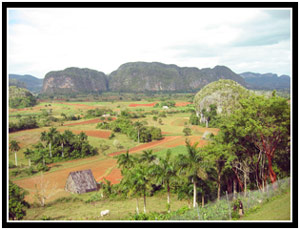
Cuevas de Santo Tomas
Speaking of caves, there’s a tour through the Cuevas de Santo Tomas that is worth paying the $8 entrance fee. It’s a fair bit out of town, though, so you’ll have to throw in cab fare, too. If you’re by yourself, ask around in the plaza to see if any other tourists happen to be headed to the same place.
What does $8 get you? A nice hard hat, headlamp, and a guide to take you through only the view first part of an absolutely huge cave structure. (If “Abel” happens to be your guide, make sure to ask him to play a little “cave music” for you.) It only takes an hour or two, but in my opinion it was so much better than heading out of town in the other direction and experiencing the tourist traps that are the Cueva del Indio and the Cueva de Viñales. Of course, with Santo Tomas, you’re out of luck if you want to ride in a skiff or dance all night under stalactites.
The best cave I went into, though, was one that wasn’t open for tourism at all. Ask a few discrete questions in town (perhaps at El Moro’s place?) to see if someone can find you a guide willing to bend the rules a little bit and take you off the beaten path. For us, that path took us 3km deep into one of the mogotes – and that awesome experience only cost $5 each!

Hotel Jazmines
If you’re not the thriftiest traveler, you might already be planning to stay at the Jazmines and will be rewarded with a great view. If you plan to stay in Viñales proper, you might want to catch a ride up to the hotel just for a glance of Viñales from above.
The hotel has a scenic viewpoint where they have a couple blurry telescopes with which you can check out the farmland and mogotes beneath you. There’s also everything else you’d expect a big hotel to have – a restaurant, gift shops, pool, etc. (Tip: If you decide to stay for lunch, save a few bucks by eating at the bar.)
I hear that the best time to sneak a peek is in the early morning, before all the mist has burned off in the valley. That could very well be, but I was there in the early afternoon.
Also, if you choose to walk back down to Viñales, you’ll likely pass a small, family farm on the left, just down the hill from of the hotel. If anyone waves to you from the field and invites you into their little tobacco field, I recommend it. If you’ve got the time, you can meet the whole extended family over homegrown coffee and then buy some homegrown, home-dried, and home-rolled cigars. You might even learn something about growing tobacco and coffee, too.
Playa Jutías
For those craving the beach, it’s possible to grab a ride to Playa Jutías. A couple hours’ ride north of Viñales is a cay that juts out into the Caribbean waters. There’s a hotel of sorts inside this national park that can serve you a basic lunch (and drinks), but not much else. Also, on the two days that my group visited this particular beach (in December), it was quite windy and a little bit cloudy. That could be a seasonal thing, or just bad luck on our part.
The beach isn’t very wide and the snorkeling is way off shore. But the water is quite warm and the beach-combing is a shell-hunter’s paradise – huge shells almost as big as my head were littered all along the beach where the waves couldn’t reach.
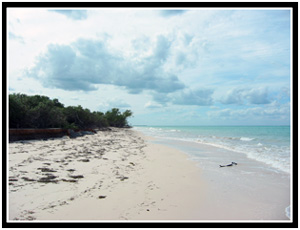
Mural de la Prehistoria
Don’t bother seeing what must be the gaudiest, tackiest, giant, pastel mural of a couple dinosaurs in all of Cuba. The pictures in your guidebook will suit you just fine.
Pinar del Rio
Pinar del Rio is close enough to Viñales that you might consider a day trip. It’s not the most tourist-oriented city in Cuba, being an agricultural hub for the area, but it does have some things worth seeing, I suppose. One of them would probably be the Fransisco Donatien cigar factory. Pay for a tour and you can see how Cuba’s famous cigars are rolled by factory workers so bored that the company hires someone just to read newspapers out loud! Or, just snap a photo or two from beyond the big windows out front, like we did.
Santa Clara
I didn’t spend as much time in Santa Clara as the rest of my group because five of us decided to strike out on our own for a trip up to the north coast. In the day or two that we spent in Santa Clara, though, I did see a couple things worth checking out.
The Che memorial is quite impressive. If you want to know a bit more about the silhouetted face that you see on so many billboards, hotels, walls, postcards, calendars, and bumper stickers in Cuba, this memorial is worth the trip. There’s a huge, bronze stature of Che situated on the top of an imposing, cement museum. Supposedly, Che’s remains were brought back from Bolivia and interred within it.
Santa Clara was a key city in Castro’s revolution. There are a number of memorials to the war there, including a neat mini-museum built in the remains of the “bullet-proof” train that Castro’s men successfully assaulted back in the 50s. Also, if you look real close (binoculars, or a long camera lens can help), you might still see bullet holes in the façade of the tallest building along the central plaza.
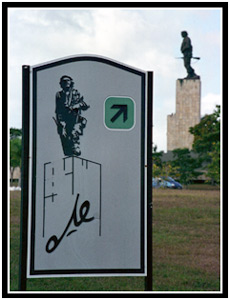
Sagua la Grande and Isabela de Sagua
When everyone tells you that there’s nothing to see in Isabela de Sagua and that there’s no chance of finding tourist housing in Sagua la Grande, believe them.
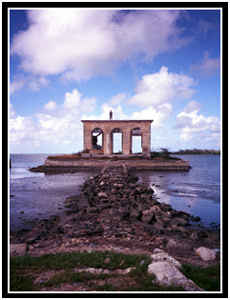
Varadero
I can’t speak with any authority on Varadero, because I’ve never been there. I have learned enough about it to realize that I probably never will. Varadero is a hotel high-rise sort of place built out on a sandy peninsula on Cuba’s Caribbean coast. The prices are high and with the exception of those working in the tourist industry; Cubans are not allowed past the front gates.
It sounds to me like Varadero is the Cancun of Cuba – catering to foreigners; it’s nothing like the rest of the country. I’ve been told that package deals come quite cheap for Canadians and Europeans looking to spend a week or two on the white-sand beaches with free cocktails always within arm’s reach.
In Havana, while a friend and I waited for the Tropicana show to begin, we found ourselves talking to four Canadians who had come to the big city just for the show. After we got over the shock of their $190US cab ride, they explained that most Canadians simply pay for an all-inclusive package to Varadero. If you don’t expect to leave the bounds of your hotel, a $1200 (Canadian) deal is all you need to spend for two weeks in Cuba.
That is, if you can call Varadero “Cuba.”
Next: (More!) Specific Recommendations

Hello
My name is Petra and I am from Germany. I saw your Tropicana Picture and was so happy to find a very good picture. I dance since 5 years salsa and my teacher was dancer at the Tropicana. It is so difficult to find picutres from the show, and I love the show. I was there two times but my place was so far away. I can’t make pictures. Do you sell yours? Could I buy a DVD or CD from you with your Tropicana picutures? Sorry for my bad English. I hope you could help me please help me.
I hope to hear from you
Petra Schwuchow